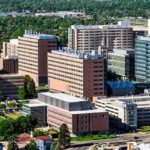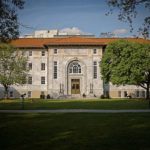
Each year, thousands of students begin researching how to get a full ride to medical school. And it makes sense, becoming a doctor isn’t cheap!
This guide will explain how likely it is to get a full ride (or other scholarships) to medical school, and give you some tips on how to get started.
Table of Contents
Can You Get A Full Ride To Medical School?
Getting into medical school is hard, but it’s also expensive. Beyond grades and adequate preparation, many students say that one of the biggest hurdles on the path to becoming a doctor is money. Medical school is not cheap, and the rising costs of education only make things harder for those who want to pursue a career in medicine.
According to the Association of American Medical Colleges, medical school graduates held an average debt burden of more than $200,000! Unfortunately, that figure turns a lot of would-be physicians away from the field entirely.
One thing that runs across the mind of nearly every medical school applicant is the possibility of getting a full ride. Can you get a full ride to medical school, or are those elusive offers nothing more than the stuff of Hollywood storytelling?
Full ride opportunities do exist. That’s the good news. Unfortunately, getting a full ride to medical school is very challenging and uncommon. These offers are few and far between.
Why Is It So Uncommon?
With the rising demand for physicians across the country, it’s hard to imagine why medical schools don’t offer full rides and scholarships more often. Investing in students is investing in the future of healthcare, so why are these offers so uncommon?
Ultimately, it all comes down to the substantial costs involved in offering a full ride.
The Association of American Medical Colleges reported that the average yearly tuition for medical school was roughly $34,592 per year for in-state students. Those attending out-of-state schools have average tuition costs of $58,668. At the end of a four-year program, you’re looking at average tuition of more than $138,000 and $226,000, respectively.
Whether the school accepts fewer than a hundred students or more than a thousand per year, full ride scholarships are simply out of reach for most institutions.
It’s important to remember that a “full ride” is not just about tuition. Many confuse full ride scholarships with full-tuition scholarships. They seem similar, but these two opportunities are vastly different.
Many schools are starting to offer tuition waivers. Essentially, they provide all accepted students with a full-tuition scholarship that covers all fees associated with studying at the school. However, those scholarships don’t cover everything else.
In addition to tuition, you have to consider living expenses, books, and more. In many cases, those additional educational costs can be just as much as tuition itself!
Getting a full ride is when the school covers the cost of your entire education. That means you’re getting full tuition, books, and a living stipend. When you add the cost of all those extras, providing more full rides becomes even more challenging for schools.
While some of the biggest names in medical education certainly have a lot of money, a vast majority of schools aren’t in the financial situation to provide free rides very often.
Let’s take a look at New York University Grossman School of Medicine. This top-tier school announced in 2018 that all current and future students would get a full-tuition scholarship. Since then, other schools have begun to follow in NYU’s footsteps.
However, most med schools can’t afford to match such a generous offer. Only 20 schools are in the same financial situation as NYU, and most of them are among the top research institutions in the country.
For other schools to offer full-tuition scholarships to every student, they’d have to spend years raising funds. It took NYU around 11 years to get an endowment fund of more than $600 million, and that’s with the school’s illustrious donors and successful alumni. Most schools around the country don’t have the prestigious connections that NYU does.
Relying on donors alone isn’t a feasible option for creating sustainable endowment funds for most schools. Plus, there’s the added risk of developing unhealthy relationships between super-wealthy donors and academic institutions with significant influence on the future of healthcare.
While some medical schools are taking steps to offer more full ride and full-tuition scholarships, there’s simply not enough funding to make these opportunities more common.
Programs, Awards & Scholarships That Can Help
Getting a true full ride to medical school is incredibly difficult. Luckily, there are plenty of other ways to help fund your education. Several awards, scholarships, and educational programs exist to help lighten the financial burden and put you well on your way to a future in medicine.
Here are several scholarship opportunities to explore.
1. Tylenol Future Care Scholarship
This annual scholarship first started over three decades ago. Since its inception, it’s continued to help medical students pursuing a career in patient care.
Several scholarships are awarded yearly. The larger award is $10,000 and goes to just ten students. However, Tylenol also rewards smaller scholarships of $5,000 to 30 students.
2. Diverse Medical Scholars Program
The Diverse Medical Scholars program is available to African-American, Latino, Native American, and Asian-American students. It helps bring more minorities into the medical profession. To qualify, applicants also have to perform 200 hours of community service and create a presentation that goes over their experience.
Thirty lucky students receive an award of $7,000 every year. The unique thing about this program is that it’s renewable. As a result, you can get funds for several years of your education.
3. Herbert W. Nickens Medical Student Scholarship
The Association of American Medical Colleges rewards this scholarship. To qualify, students must be nominated by their medical school.
It’s only available to third-year medical students and prioritizes those who make medical education more accessible to minorities.
4. Physicians of Tomorrow
Here’s another scholarship that’s exclusive to medical students in their third year of study. Those interested in this reward must get a nomination from their school’s dean.
Ten separate scholarships of $10,000 are rewarded. A couple of them are dedicated to specific types of students. For example, one is exclusive to minority students while another is given to a student studying women’s health.
5. David Geffen Medical Scholarship
The David Geffen Medical Scholarship is merit-based and awarded to students at UCLA. It’s a generous reward that covers four full years of attendance. It’s a true full ride scholarship for medical school that includes financial aid for tuition, room and board, books, and more.
6. Perelman School of Medicine Scholarships
For students applying to the University of Pennsylvania’s school of medicine, these scholarships cover 100 percent of all tuition costs. There are a total of 25 scholarships given every year. Every student accepted into the school is automatically considered for the reward.
7. National Health Service Corps Program
This highly competitive scholarship can provide funds for two years of medical school tuition and fees. It can also include a living stipend. Accepting the reward does come with some stipulations.
It’s designed to attract those who are passionate about serving underprivileged communities. The scholarship requires one year of service as a primary care provider in an underserved area after residency. The requirement applies to each year of funding you get.
The program pays for a minimum of two years of study.
8. Paul & Daisy Soros Fellowship for New Americans
This program is for immigrants or children of immigrants. Fellows of the program can get up to $90,000 of financial support over a two-year period. This program was founded in 1998 and has already helped more than 700 immigrant students become successful medical professionals.
9. Abigail Geisinger Scholars Program
The Abigail Geisinger Scholar program is a conditional funding program. It’s only available to students specializing in family medicine, internal medicine, medicine-pediatrics, or psychiatry. Those who qualify may get funding for tuition plus $2,000 every month as a living stipend.
Like other conditional programs, those who accept the scholarship must work as doctors for the Geisinger health care organization. They must commit to working for Geisinger for the same number of years they received funding.
10. NYU School of Medicine
The NYU Grossman School of Medicine offers full-tuition scholarships for every student accepted into the MD program. As long as the student maintains satisfactory academic marks, the scholarship applies to all four years of study. It’s available to all students regardless of financial need or merit.
As you can imagine, this has helped make it one of the most competitive medical schools in New York.
11. Cornell University School of Medicine
Cornell also has a full ride scholarship for medical school. Weill Cornell Medical College plans to eliminate debt by replacing it with scholarships that cover tuition, housing, and living expenses.
These scholarships are based on financial needs. Any student that qualifies for standard financial aid will receive a scholarship.
12. Columbia University Vagelos College of Physicians and Surgeons
Columbia’s medical school has a similar program to Cornell’s. It’s a full ride scholarship that’s designed to replace medical education debt.
It, too, applies to those who qualify for financial aid.
13. Kaiser Permanente School of Medicine
Kaiser Permanente is a new school that just launched in 2020. For its first five classes, Kaiser plans to waive all tuition and fees. The full-tuition scholarship is available to all students and will cover all four years of education.
14. Cleveland Clinic Lerner College of Medicine
All students accepted into the Cleveland Clinic Lerner College of Medicine qualify for a full-tuition scholarship. The program covers both tuition and fees. However, it doesn’t include living expenses, books, and other educational costs.
The Power Of Negotiation
For the most, medical schools have the upper hand during application season. Approximately 50,000 potential students apply to medical schools each year, but 60 percent don’t gain acceptance. Top-tier schools are notoriously selective, which is another reason why full ride offers are scarce.
While medical schools don’t need to entice students, many will go above and beyond to attract the brightest minds. If you have the academic chops to back it up, it is possible to use your powers of negotiation to get a full ride or full-tuition scholarship.
Of course, this option isn’t going to work for everyone, but it’s an underrated strategy that many don’t even realize is on the table!
Say, for example, that you’re in the upper percentile ranks of MCAT scores and have a very competitive application. There’s a good chance that you will get accepted into many of the schools you apply for (here’s a guide on how many medical schools you should apply to). Once those acceptance letters start rolling in, use them as leverage.
Contact the Dean of Admissions at the school you want to attend. Medical schools understand that financial matters can ultimately sway a student’s decision. A well-timed letter or phone call can make the admissions committee reevaluate their acceptance offer.
Who knows? They could offer more scholarships, in-state tuition rates, or even a full ride. It’s a long shot, but students have seen success negotiation scholarship opportunities in the past.
An Overlooked Option
If you’re still trying to figure out how to get a full ride to medical school, there is one option worth considering.
Join the military.
If you already served as a member of the armed forces, you can qualify for the Health Professions Scholarship Program, or HPSP for short.
HPSP covers tuition and fees. Not only that, but you can get a living stipend. To meet eligibility requirements, you must serve one year of active duty for every year of scholarship funding. You must serve a minimum of three years to claim the reward.
Another option is to attend USU, also known as the Uniformed Services University. The F. Edward Hebert School of Medicine offers a full health sciences graduate program.
All students at USU are commissioned officers of the United States Public Health Service, Air Force, Army, or Navy. As a student at USU, you can study tuition-free. Plus, you can earn a salary of up to $70,000 per year.
In return for a salary and free education, you must complete at least seven years of active-duty service after your residency.
Closing Thoughts
Getting a full ride to medical school is extremely unlikely, but not impossible. If you’re the right candidate (and have luck on your side) it’s always worth a shot!
But even if a full ride is unrealistic, there are other scholarships and options you can pursue. You’d be surprised how many applicants don’t know about this, so take advantage!




